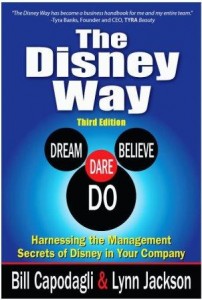Do: Create Plan to become the Best Show & Monitor
Carefully Managed Creativity, The Disney Way
There have always been two basic schools of thought on business creativity. The first insists that researchers and other in-house innovators be given the loosest rein possible, allowing new ideas and projects to develop on their own momentum with a maximum of independent decision making. The second approach demands that the reins be kept taut,that the generation of ideas is part of the corporate process, and like the other parts, that it be carefully managed.
Walt Disney was definitely of the second school. Although his famously forceful and controlling management style was largely attributable to his personality, there was also a practical consideration: the cost of making animated pictures. Makers of live-action films could shoot extra footage and then piece together their final product through artful cutting in the editing room, but animation costs were such that cartoon makers couldn’t even consider this whittle-down approach.
So to keep costs in check, Disney exercised extremely tight control of the creative process itself by instituting a rigorous, nine-step regimen for project management. Only by demanding that his people follow7 this standard procedure could he continue to turn dreams into tangible products, whether he was dealing with films, amusement parks, television shows, or any of the other Disney enterprises. In the Disney system, nothing was or is left to chance. The Disney Way, 3E: Harnessing the Management Secrets of Disney in Your Company.
 This may surprise a lot of people that the process was so tightly controlled. But I think creativity thrives with a rigorous process. It simply gives more time to be creative. How many good ideas have been wasted because of a poor plan?
This may surprise a lot of people that the process was so tightly controlled. But I think creativity thrives with a rigorous process. It simply gives more time to be creative. How many good ideas have been wasted because of a poor plan?
The Do stage The Disney Way leaves little to chance. We build in financial results, the cast and the guest experience through the use of storyboards, and improvement efforts. But in addition, we are developing and evaluating our monitoring practices all the time.
One of my favorite subjects is Outcome Mapping and one of the reasons is it emphasis on evaluation and monitoring. In this process, they monitor outcomes, performance, and strategy with regular evaluation. I find that very similar in the Disney approach that there is an emphasis not only on collecting data but maybe even more in what I might choose to call the Lean term of going to Gemba. Even more importantly, maybe who is going to Gemba. Many of the stories that I have heard involved Walt Disney himself making suggestions about little things that could be noticed if only he was the person that was there and participating.
Also in the Do Stage, we use Storyboarding as a visual display and monitoring techniques. What I really like the efforts that are used to capture Customer Feedback as part of the Storyboarding effort. Making this feedback visual, I believe makes it more real and creates an urgency.
The Dream-Believe-Dare-Do cycle of The Disney Way has a very similar approach to Lean, and Deming/Shewart’s PDCA or maybe the terminology of CAP-Do would be more fitting. However, what I think the Disney Way, mostly because of the legacy of Walt Disney, does better than most planning or improvement cycles, it the Dream. Capturing the story and instilling the Dream for an outcome is still the most effective way of achieving any “Dream” or solving any problem.
And to think it all happened because of a Mouse is,
even more, of a reason to believe in the Disney Way.
Walt Disney’s original success formula, “Dream, Believe, Dare, Do”, can transform both entrepreneurial and Fortune 500 companies alike. Bill Capodagli is the co-author of The Disney Way, 3E, along with several other books (I have them all), and can be found at Capodagli Jackson Consulting.
This is the fourth of a series of posts this week on the Four Stages of The Disney Way: Dream, Believe, Dare, Do.

